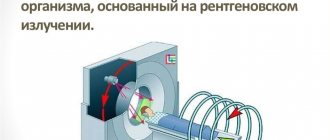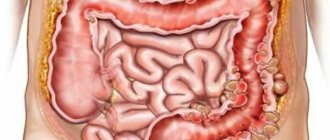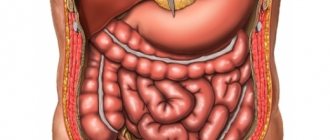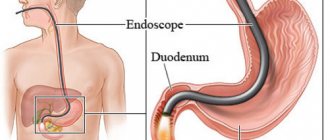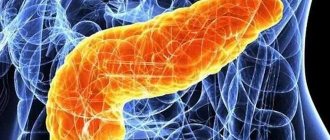What is gastrointestinal ultrasound
Ultrasound of the gastrointestinal tract is an accurate diagnostic procedure that detects even minor pathological changes. The technique is based on the use of ultrasonic waves. They are able to pass through the skin and muscles, and ultrasound is reflected from the denser organs of the gastrointestinal tract.
The reflected waves are captured by the sensor and transmitted to the computer. Here they are processed and transformed into an image. This way the doctor can see the condition of the internal organs.
What is included in the scope of the study depends on the patient's symptoms. The doctor may order an examination:
- liver and gallbladder;
- pancreas;
- spleen.
In most cases, a comprehensive ultrasound is performed, that is, all organs of the gastrointestinal tract are examined at once.
Ultrasound of the hollow organs of the abdominal cavity - the stomach and intestines - is rarely performed. They contain air, which does not reflect ultrasound, so they are not visible on regular photographs. To examine these organs of the gastrointestinal tract, special techniques are required - water-siphon test, contrast.
The doctor will tell you about ultrasound examination of the gastrointestinal tract in the video:
How does an ultrasound examination of the stomach occur?
Ultrasound examination (ultrasound) is an informative, non-invasive, practically safe examination of human internal organs. The main obstacle to performing an ultrasound is the presence of air. Therefore, the main task of preparing for an ultrasound examination is to remove all excess air from the intestines. Preparation for ultrasound is especially important for obese people, since fat is the second most important obstacle to ultrasound.
Ultrasound can be used to examine parenchymal organs, as well as hollow organs filled with fluid. In the abdominal cavity, these include the liver, gall bladder, pancreas and spleen, and bile ducts. The kidneys are anatomically located in the retroperitoneum, but they are usually examined together with the above-mentioned abdominal organs.
The intestines and stomach are hollow organs in which air is almost always present, so it is extremely difficult to examine them. And although very good preparation of the patient for ultrasound allows for partial examination of the walls of the stomach and colon, these techniques are extremely complex, time-consuming and painful for patients (the colon is first completely emptied using siphon enemas, and then filled with liquid). Therefore, to examine the intestines, a simpler and more informative method is used - colonoscopy.
Preparing for an ultrasound of the stomach
The study is carried out strictly on an empty stomach (at least 6, and preferably 12 hours after eating). For example, the pancreas in a living person is located behind the stomach, and when the stomach is full, it is practically invisible on ultrasound.
The examination of the stomach is carried out strictly on an empty stomach at least 6 and preferably 12 hours after eating
For 2–3 days do not consume brown bread, milk, carbonated water and drinks, vegetables, fruits, juices, confectionery, and alcohol. In the absence of contraindications, you can also take any enterosorbent (polysorb, polyphepan, “white coal”, enterosgel) in a standard dosage; it is also advisable to do a cleansing enema 1.5–2 hours before the test.
Procedure for examining the stomach with a water-siphon test
When the echography method is used, a water siphon test is often used. It is used to clarify the diagnosis and determine the motor function of the stomach.
This method is shown:
- for pain in the abdomen;
- constant heartburn and belching after eating;
- with excessive regurgitation in infants;
- with ulcerative lesions;
- for chronic constipation and colitis;
- in the presence of polyps.
This technique is carried out in two stages: on an empty stomach and after eating.
Indications for use
The main indication for prescribing a gastrointestinal ultrasound is the presence of complaints and symptoms indicative of a disease in the patient. These include:
- discomfort or pain in the abdomen;
- constant nausea;
- bloating;
- stool disorder;
- yellowing of the skin;
- changes in biochemical blood test.
Ultrasound is prescribed to people with chronic gastrointestinal diseases to monitor dynamics. The child is examined at the age of 14 as a routine medical examination.
Preparation rules
When prescribing the procedure, the doctor explains to the patient how to prepare for an ultrasound of the gastrointestinal tract. Preparation is needed to eliminate conditions that can distort the examination result. During a routine examination, the preparatory stage takes three days.
A diet of foods that do not cause gas formation in the intestines is prescribed:
- lean meat;
- buckwheat grain;
- kefir;
- crackers;
- Herb tea.
Food is taken in small portions, 5-6 times a day. You should not eat before a gastrointestinal ultrasound:
- fatty meat, fish, lard;
- smoked meats, canned products;
- legumes;
- cabbage;
- black bread;
- raw vegetables and fruits.
Come to the procedure on an empty stomach. Dinner is allowed no later than 12 hours before the test. In the morning, a person does not have breakfast; you can drink water before an ultrasound of the gastrointestinal tract in small quantities.
More information about preparing for an abdominal ultrasound:
Diet before ultrasound of the stomach
An important step in preparing for an ultrasound of the abdominal organs is the use of foods that prevent gas formation. The main idea of the diet is to eat light foods. Doctors recommend starting preparations three days before the scheduled examination date. A special diet before an ultrasound of the abdominal organs is aimed at reducing the formation of gases in the patient’s intestines and stomach.
During the day, you need to have frequent meals in the range of 3-4 hours in small portions no larger than your fist. An hour before and an hour after a meal, you can drink weak tea without sugar or non-carbonated water, but the main thing is not to drink while eating. During the day you need to drink one and a half liters of any liquid, preferably plain water without gas. It is strictly forbidden to drink alcohol, even in small doses, three days before the procedure; the presence of alcohol in the body can distort the results of the study.
Dietary foods recommended before an abdominal ultrasound that reduce the risk of gas formation include:
- beef;
- chicken or turkey meat;
- low-fat fish;
- soft-boiled or hard-boiled chicken egg (only one per day);
- oatmeal (buckwheat) porridge, cooked in water without butter;
- low-fat hard cheeses.
Before an ultrasound of the stomach, you need to drink one and a half liters of any liquid during the day, preferably plain water without gas.
It is preferable to use steamed or boiled cooking methods. During preparation, it is necessary to exclude spicy, fried and smoked foods from the diet. The diet must be followed for all three days until the evening before an ultrasound of the abdominal organs, if the examination is scheduled for the morning. It is necessary to eat light foods on this day; you cannot go completely hungry the day before the procedure. If the reception hours are after 15:00 the next day, a small amount of light food is allowed at 8-10 am.
An ultrasound of the abdominal organs is performed on an empty stomach. You can drink it in the morning if you are planning a bladder ultrasound. In other cases, it is better to avoid drinking water. In case of preparation for an ultrasound of the gallbladder, the doctor may prescribe you to eat sour cream in the morning on an empty stomach or drink a few tablespoons of vegetable oil. If you experience flatulence in the morning, it is recommended to do a cleansing enema. It is strictly forbidden to smoke on the day of the examination, because smoke may cause unclear and incorrect images.
How ultrasound is done for adults and children
An ultrasound examination is usually performed in the morning. You need to take a disposable sheet and towel with you to the examination. The patient is placed on the couch, the stomach is exposed. A sound-conducting gel is applied to the skin.
The doctor passes the sensor along the abdomen in the places where the gastrointestinal tract organs are located. The inspection takes 15-20 minutes. The gel is washed off with a towel at the end of the procedure.
In children, the examination is carried out in the same way. Parents are advised to explain to the child in advance that it will not hurt. Infants are usually held in their arms while the doctor examines them.
Watch the video of how an ultrasound examination of the intestines is done:
Possible results
Ultrasound examination reveals various diseases of the gastrointestinal tract. If the procedure is carried out for preventive purposes, a variant of the norm is identified.
Normal indicators
Healthy gastrointestinal organs must meet the following criteria:
- sizes according to age;
- smooth and clear contours;
- homogeneous fine-grained structure;
- the density of the liver, pancreas and spleen is approximately the same.
The organ sizes of adult men and women are almost the same. In children they change with age. When examining, pay attention to the diameter of the portal vein of the liver, bile and pancreatic ducts.
Description of diseases
Each gastrointestinal disease has its own signs on ultrasound.
- Inflammation of the liver is called hepatitis. In the picture, the liver is enlarged in size, darker than a healthy organ.
- Inflammation of the pancreas - pancreatitis. An increase in its size is detected, it becomes darker. The structure changes from fine-grained to coarse-grained.
- Inflammation of the gallbladder - cholecystitis. Its wall thickens, and thick contents are visible in the cavity. Sometimes gallstones form in the bladder - then it is called calculous.
- Cirrhosis of the liver is characterized by the formation of scars in the liver. They are clearly visible in the picture in the form of white spots and stripes. At the last stage of cirrhosis, the liver becomes completely white and decreases in size.
- Cysts can form in any organ. They are round cavities filled with air or liquid. In the image, the cysts are visible as dark spots with a lighter edging.
- Gastrointestinal tumors are detected as light spots. Benign ones have a round shape with clear boundaries. Malignant tumors have blurry contours.
The doctor conducting the examination describes the changes he saw in the conclusion. The final diagnosis is made by the attending physician based on ultrasound data and other examination methods.
Considering that ultrasound of the stomach and intestines can show little information, radiography is prescribed for diseases of these organs.
Read more about diseases of the stomach, intestines and other gastrointestinal organs in the relevant articles.
When and why you need to do an abdominal ultrasound
If you are concerned about pain in the upper abdomen or a feeling of heaviness in the right hypochondrium, bitterness in the mouth, increased gas formation in the intestines, then you need to consult a gastroenterologist, who, in turn, will refer you to an ultrasound scan of the abdominal cavity. It is advisable to do an ultrasound examination every year in terms of medical examination.
It is advisable to do an ultrasound examination every year; in terms of clinical examination, the stomach and duodenum are also examined using ultrasound
The protocol for ultrasound examination of the abdominal organs includes examination of the gallbladder, pancreas, liver, spleen, stomach and duodenum. An ultrasound doctor evaluates the size and location of organs, their internal structure, as well as the presence of space-occupying formations and free fluid in the abdominal cavity.
Based on these characteristics, the specialist makes a conclusion about the presence or absence of changes. In other words, having received an ultrasound “picture”, it becomes possible to “see” the structure of these organs, and sometimes even suspect a violation of their function. The stomach and duodenum are also examined using ultrasound. After food passes into the mouth and esophagus, it enters the stomach and then the duodenum.
In the stomach, it is mixed, exposed to hydrochloric acid, and in the duodenum, food is exposed to pancreatic enzymes, since the pancreatic duct opens into this section of the digestive tract. The study evaluates the thickness of the stomach walls, the presence or absence of secretions in them. Signs of hypersecretion (increased production of digestive juices, the presence of fluid in the stomach cavity even on an empty stomach) are indirect ultrasound symptoms of gastritis.
Indications for ultrasound of the stomach
Most patients prefer to use ultrasound instead of gastroscopy when examining the esophagus, stomach and intestines. These two methods are completely different, but are prescribed to detect any pathologies in the abdominal organs. Often this type of diagnosis is recommended as a primary procedure. Experts always prescribe examination of those areas that have a thick muscle layer and high echogenicity to reflect ultrasound waves.
Ultrasound is prescribed if:
- for acute or chronic gastritis;
- for ulcerative lesions of the stomach or small intestine;
- for the formation of polyps or other benign tumors;
- on the development of cancer.
Contraindications for examination
Ultrasound diagnostics is distinguished by its safety. It is performed on children from birth, pregnant women, and the elderly. Contraindications are due to conditions that may distort the results:
- pronounced flatulence;
- extensive inflammation and wounds of the skin on the abdomen;
- alcohol or drug intoxication;
- psychosis.
In emergency cases, a gastrointestinal examination can be performed even in the presence of these conditions.
